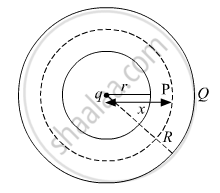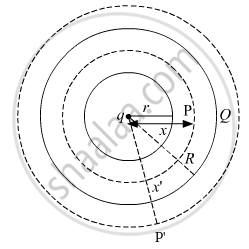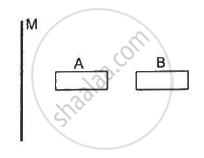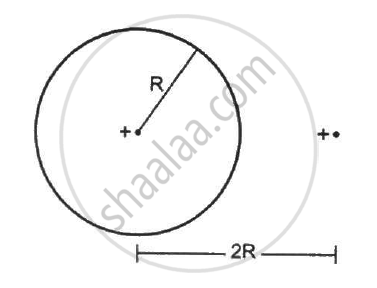Advertisements
Advertisements
प्रश्न
A small conducting sphere of radius 'r' carrying a charge +q is surrounded by a large concentric conducting shell of radius Ron which a charge +Q is placed. Using Gauss's law, derive the expressions for the electric field at a point 'x'
(i) between the sphere and the shell (r < x < R),
(ii) outside the spherical shell.
उत्तर १
Consider a sphere of radius r with centre O surrounded by a large concentric conducting shell of radius R.

To calculate the electric field intensity at any point P, where OP = x, imagine a Gaussian surface with centre O and radius x, as shown in the figure given above.
The total electric flux through the Gaussian surface is given by
`ø = oint_s Eds = E oint_s \ ds`
Now,
`oint \ ds = 4πx^2`
`∴ø = E xx 4πx^2 ....... (1) `
Since the charge enclosed by the Gaussian surface is q, according to Gauss's theorem,
`ø = q/ε_0 ....... (2)`
From (i) and (ii), we get
` E xx 4πx^2 = q/ε_0 `
⇒`E = q/(4πε_0x^2 )`
उत्तर २
(1) Consider a sphere of radius r with centre O surrounded by a large concentric conducting shell of radius R.

To calculate the electric field intensity at any point P, where OP = x, imagine a Gaussian surface with centre O and radius x, as shown in the figure given above.
The total electric flux through the Gaussian surface is given by
`ø = oint_s Eds = E oint_s \ ds`
Now,
`oint \ ds = 4πx^2`
`∴ø = E xx 4πx^2 ....... (1) `
Since the charge enclosed by the Gaussian surface is q, according to Gauss's theorem,
`ø = q/ε_0 ....... (2)`
From (i) and (ii), we get
` E xx 4πx^2 = q/ε_0 `
⇒`E = q/(4πε_0x^2 )`
(2)

To calculate the electric field intensity at any point P', where point P' lies outside of the spherical shell, imagine a Gaussian surface with centre O and radius x', as shown in the figure given above.
According to Gauss's theorem,
` E' xx 4πx^'2 = (q+Q)/ε_0 `
⇒`E = (q+Q)/(4πx'^ 2 )`
As the charge always resides only on the outer surface of a conduction shell, the charge flows essentially from the sphere to the shell when they are connected by a wire. It does not depend on the magnitude and sign of charge Q.
APPEARS IN
संबंधित प्रश्न
Use Gauss's law to find the electric field due to a uniformly charged infinite plane sheet. What is the direction of field for positive and negative charge densities?
Two large, thin metal plates are parallel and close to each other. On their inner faces, the plates have surface charge densities of opposite signs and of magnitude 17.0 × 10−22 C/m2. What is E:
- in the outer region of the first plate,
- in the outer region of the second plate, and
- between the plates?
Using Gauss's law in electrostatics, deduce an expression for electric field intensity due to a uniformly charged infinite plane sheet. If another identical sheet is placed parallel to it, show that there is no electric field in the region between the two sheets ?
A point object is placed on the principal axis of a convex spherical surface of radius of curvature R, which separates the two media of refractive indices n1 and n2 (n2 > n1). Draw the ray diagram and deduce the relation between the object distance (u), image distance (v) and the radius of curvature (R) for refraction to take place at the convex spherical surface from rarer to denser medium.
A charge Q is uniformly distributed on a spherical shell. What is the field at the centre of the shell? If a point charge is brought close to the shell, will the field at the centre change? Does your answer depend on whether the shell is conducting or non-conducting?
A rubber balloon is given a charge Q distributed uniformly over its surface. Is the field inside the balloon zero everywhere if the balloon does not have a spherical surface?
A large non-conducting sheet M is given a uniform charge density. Two uncharged small metal rods A and B are placed near the sheet as shown in the following figure.
(a) M attracts A.
(b) M attracts B.
(c) A attracts B.
(d) B attracts A.

Find the flux of the electric field through a spherical surface of radius R due to a charge of 10−7 C at the centre and another equal charge at a point 2R away from the centre in the following figure.

A spherical volume contains a uniformly distributed charge of density 2.0 × 10 -4 Cm-3 Find the electric field at a point inside the volume at a distance 4⋅0 cm from the centre.
A circular wire-loop of radius a carries a total charge Q distributed uniformly over its length. A small length dL of the wire is cut off. Find the electric field at the centre due to the remaining wire.
